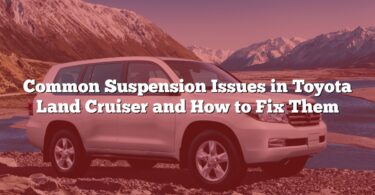Seeing your Toyota Land Cruiser’s brake light stay on can be both alarming and confusing. This warning light is your vehicle’s way of signaling that something in the braking system needs attention. From simple issues like low brake fluid to more complex problems such as ABS system faults, understanding the potential causes and solutions can help you address the issue quickly and keep your Land Cruiser running safely. In this guide, we’ll explore 24 common problems and their solutions to help you troubleshoot and resolve the issue effectively.
Problems and Solutions: Why Your Toyota Land Cruiser’s Brake Light Stays On
| N° | Problem/Cause | Solution |
|---|---|---|
| 1 | Low brake fluid level | Check and refill the brake fluid to the recommended level. |
| 2 | Worn brake pads | Inspect and replace the brake pads if worn. |
| 3 | Faulty brake fluid sensor | Replace the faulty brake fluid sensor. |
| 4 | Parking brake not fully released | Ensure the parking brake is fully disengaged. |
| 5 | Damaged or stuck parking brake switch | Repair or replace the parking brake switch. |
| 6 | Malfunctioning brake light switch | Replace the brake light switch. |
| 7 | Hydraulic pressure imbalance | Inspect the hydraulic system and rebalance or repair as needed. |
| 8 | ABS system fault | Diagnose the ABS system using a scanner and repair the issue. |
| 9 | Faulty ABS module | Replace the ABS module if confirmed defective. |
| 10 | Electrical wiring issues | Inspect and repair damaged or corroded wiring. |
| 11 | Blown fuse related to the braking system | Replace the blown fuse with one of the correct rating. |
| 12 | Faulty brake master cylinder | Repair or replace the brake master cylinder. |
| 13 | Contaminated brake fluid | Flush and replace the brake fluid with fresh fluid. |
| 14 | Air in the brake lines | Bleed the brake lines to remove air. |
| 15 | ECU malfunction | Reset or reprogram the ECU, or replace it if necessary. |
| 16 | Failed brake pedal position sensor | Replace the brake pedal position sensor. |
| 17 | Brake booster issues | Inspect the brake booster and repair or replace it if defective. |
| 18 | Corroded or damaged brake system connectors | Clean or replace corroded or damaged connectors. |
| 19 | Aftermarket modifications affecting the brake system | Revert or adjust the modifications to restore functionality. |
| 20 | Software glitch in the onboard computer system | Update the onboard software or reset the system. |
| 21 | Low battery voltage | Charge or replace the vehicle’s battery. |
| 22 | Broken wheel speed sensor wire | Replace or repair the broken sensor wire. |
| 23 | Bad wheel bearing | Replace the faulty wheel bearing. |
| 24 | Dirty tone ring | Clean the tone ring to ensure proper ABS sensor function. |
Detailed Guide :Problems and Solutions: Why Your Toyota Land Cruiser’s Brake Light Stays On
1. Low Brake Fluid Level
The brake fluid level might drop due to:
- Leaks in the brake lines or master cylinder.
- Worn brake pads causing fluid displacement.
Solution:
- Check the brake fluid reservoir under the hood. If the level is below the “MIN” mark:
- Inspect for visible leaks in the brake lines and connections.
- If no leaks are found, refill the reservoir with manufacturer-recommended brake fluid.
- Monitor the fluid level regularly to identify recurring drops.
- If leaks are identified, repair the damaged components and then refill the reservoir.
2. Worn Brake Pads
As brake pads wear down, the brake fluid in the reservoir gets displaced, potentially causing the brake light to stay on.
Solution:
- Inspect the thickness of the brake pads:
- If the pads are less than the recommended thickness (typically 3mm), replace them.
- After replacing the brake pads, ensure the brake fluid level is correct, as new pads may raise the fluid level.
3. Faulty Brake Fluid Sensor
The sensor in the reservoir might fail, causing a false brake light warning.
Solution:
- Test the sensor’s functionality using a multimeter.
- If the sensor is defective, replace it. Ensure the new sensor is compatible with your Land Cruiser.
4. Parking Brake Not Fully Released
The brake light can stay on if the parking brake is partially engaged.
Solution:
- Ensure the parking brake lever or pedal is fully disengaged.
- If the brake light remains on:
- Inspect the parking brake cable for tightness or damage.
- Lubricate or adjust the cable if needed.
- Replace damaged components.
5. Damaged or Stuck Parking Brake Switch
A faulty parking brake switch might fail to detect when the brake is disengaged.
Solution:
- Locate the parking brake switch near the pedal or lever.
- Inspect for physical damage or dirt.
- Clean or replace the switch if necessary.
6. Malfunctioning Brake Light Switch
The switch at the brake pedal might be misaligned or defective.
Solution:
- Check the alignment of the switch.
- Adjust or replace the switch as needed. Ensure the new switch clicks when the pedal is pressed.
7. Hydraulic Pressure Imbalance
An imbalance in the hydraulic brake system can trigger the brake warning light.
Solution:
- Inspect the hydraulic system, including the master cylinder and brake lines.
- Rebalance or repair the system as necessary, ensuring proper brake fluid pressure.
8. ABS System Fault
A malfunction in the anti-lock braking system can cause both ABS and brake lights to illuminate.
Solution:
- Use an OBD-II scanner to read ABS codes.
- Repair the specific fault, such as replacing a damaged wheel speed sensor or faulty module.
9. Faulty ABS Module
The ABS module might fail, impacting brake light functionality.
Solution:
- Test the ABS module using diagnostic equipment.
- Replace the module if it is defective. Ensure proper programming and calibration of the new module.
10. Electrical Wiring Issues
Damaged or corroded wiring can disrupt signals, causing the brake light to stay on.
Solution:
- Inspect wiring around the brake system for visible damage or corrosion.
- Repair or replace affected wires and connectors.
11. Blown Fuse Related to the Braking System
A blown fuse can interfere with brake light operation.
Solution:
- Locate the fuse box and identify the brake system fuse using the owner’s manual.
- Replace the blown fuse with one of the correct amperage.
12. Faulty Brake Master Cylinder
A malfunctioning master cylinder can cause pressure issues, triggering the brake light.
Solution:
- Inspect the master cylinder for leaks or damage.
- Replace the cylinder if it’s faulty. After replacement, bleed the brake system to remove air.
13. Contaminated Brake Fluid
Debris or moisture in the brake fluid can impair the system’s operation.
Solution:
- Flush the brake fluid using fresh fluid as per the manufacturer’s recommendations.
- Ensure all old fluid is fully removed before refilling.
14. Air in the Brake Lines
Air trapped in the brake lines can reduce braking efficiency and trigger the brake light.
Solution (Step by Step):
- Open the brake bleeder valves on each wheel.
- Attach a clear tube to the valve and place the other end in a container of brake fluid.
- Pump the brake pedal to push air out.
- Close the valve when only fluid is visible in the tube.
- Repeat for all wheels, ensuring the brake fluid reservoir remains topped up.
15. ECU Malfunction
The electronic control unit might misinterpret brake system data.
Solution:
- Reset the ECU using an OBD-II scanner.
- If the issue persists, reprogram or replace the ECU.
16. Failed Brake Pedal Position Sensor
This sensor might fail, causing inaccurate readings and triggering the brake light.
Solution:
- Test the sensor with a multimeter.
- Replace the sensor if readings are outside specifications.
17. Brake Booster Issues
A faulty brake booster can cause abnormal pressure in the brake system.
Solution:
- Test the booster for vacuum leaks.
- Repair or replace the booster if necessary.
18. Corroded or Damaged Brake System Connectors
Corrosion can disrupt electrical signals in the brake system.
Solution:
- Clean corroded connectors using electrical contact cleaner.
- Replace connectors that are severely damaged.
19. Aftermarket Modifications Affecting the Brake System
Modifications might interfere with brake light operation.
Solution:
- Review recent modifications.
- Revert or adjust modifications to restore proper brake system functionality.
20. Software Glitch in the Onboard Computer System
A software error might cause false brake light warnings.
Solution:
- Update the onboard computer software at a dealership.
- Reset the system after updating.
21. Low Battery Voltage
Insufficient voltage can cause brake light malfunctions.
Solution:
- Test the battery with a voltmeter.
- Charge or replace the battery if it falls below recommended levels.
22. Broken Wheel Speed Sensor Wire
A broken wire can disrupt ABS readings, triggering the brake light.
Solution:
- Inspect the wires near the wheel speed sensors.
- Repair or replace damaged wires.
23. Bad Wheel Bearing
A failing wheel bearing can impact ABS functionality and trigger the brake light.
Solution:
- Inspect for play or noise in the wheel bearing.
- Replace the bearing if defective.
24. Dirty Tone Ring
Debris on the tone ring can affect ABS sensor readings.
Solution:
- Clean the tone ring using a soft brush and brake cleaner.
- Ensure all debris is removed before reassembly.
Preventing Future Issues
To avoid encountering brake light problems with your Toyota Land Cruiser in the future, follow these steps to ensure the longevity and proper functioning of your braking system:
1. Regular Brake Fluid Checks:
- Inspect the brake fluid reservoir monthly.
- Ensure the fluid is between the “MIN” and “MAX” marks.
- Use only the manufacturer-recommended brake fluid.
2. Routine Brake Pad Inspections:
- Check the brake pads every 10,000 miles or during routine service.
- Replace pads if the thickness is less than the recommended level.
3. Clean and Maintain Sensors and Connectors:
- Periodically clean ABS sensors and tone rings to prevent dirt accumulation.
- Inspect connectors for corrosion and clean them with electrical contact cleaner.
4. Bleed the Brake Lines as Needed:
- Perform a brake line bleed whenever air is suspected in the system or during brake fluid replacement.
- Ensure no air bubbles remain in the lines for optimal braking performance.
5. Test Parking Brake Functionality:
- Regularly engage and release the parking brake to ensure smooth operation.
- Lubricate or adjust the cable annually if needed.
6. Monitor Battery Health:
- Check the battery voltage and terminals every three months.
- Replace the battery if it consistently falls below the recommended voltage.
7. Address Warning Lights Immediately:
- Never ignore a brake or ABS warning light.
- Use an OBD-II scanner to diagnose issues early and prevent further damage.
8. Avoid Overloading or Excessive Braking:
- Refrain from carrying excessive loads that strain the braking system.
- Avoid long periods of brake application during descents to prevent overheating.
9. Schedule Regular Maintenance:
- Follow the manufacturer’s maintenance schedule for the braking system.
- Have a professional inspect the entire system during every scheduled service.
10. Update Onboard Software:
- Visit a dealership or authorized service center annually to ensure the onboard computer system is running the latest software version.
By adhering to these preventive steps, you can minimize the likelihood of brake light issues and ensure the safety and reliability of your Toyota Land Cruiser.







